Is it art or copying? —
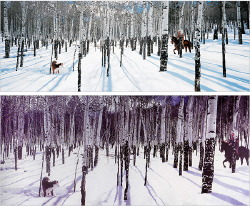 Cranky Media Guy
Cranky Media Guy sent me
an interesting link to an article published last December in the New York Times about the artist
Richard Prince. He's described as a pioneer of
"appropriation art." What this means is that Prince takes photographs of other photographer's photographs, and then displays them as his own. For instance, he had an exhibit at the Guggenheim about cowboys, which basically consisted of photographs of Marlboro ads. The guy who actually took the images for the Marlboro ads, the photographer Jim Krantz, visited the exhibit and was like, "Hang on, those are my photographs!"
In the thumbnail, you can see Krantz's original photograph on top, and Prince's rephotograph of it on the bottom.
Prince doesn't try to hide what he does. And art critics love his work. According to the NY Times: "one of the Marlboro pictures set an auction record for a photograph in 2005, selling for $1.2 million." That's good money for a photograph of someone else's photograph.
It raises the question, is this really art, or is it just mindless copying? To which the answer, as always, is that art is whatever art critics say is art (and whatever the courts allow artists to get away with).
Generally I take a very liberal attitude about copyright. I think it's necessary that people are allowed to copy works of art in order to be able to comment upon them, criticize them, or develop them into something new and different. But what Prince is doing looks more to me like glorified scrapbooking than creating original art.
It also reminds me of the scam that art museums try to use to establish perpetual copyright to the works in their collection. They take photographs of all the paintings they own that have passed into public domain. Then they claim that, while the original might be in the public domain, their picture of it is copyrighted -- and then they demand exorbitant fees from anyone who wants to reproduce it.

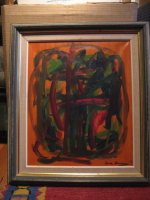 I received an email from Maria in Sweden who reports that when her mother recently passed away she became the owner of a painting by Pierre Brassau, the monkey artist. (See the article about Pierre Brassau in the hoaxipedia. To sum up the story: in 1964 a Swedish reporter placed some paintings drawn by a monkey in an art show, claiming they were the work of an avant-garde French artist, Pierre Brassau. After critics praised the paintings, he revealed the hoax.) Apparently Maria's mother had received the painting in 1970 as a gift and had kept it ever since.
I received an email from Maria in Sweden who reports that when her mother recently passed away she became the owner of a painting by Pierre Brassau, the monkey artist. (See the article about Pierre Brassau in the hoaxipedia. To sum up the story: in 1964 a Swedish reporter placed some paintings drawn by a monkey in an art show, claiming they were the work of an avant-garde French artist, Pierre Brassau. After critics praised the paintings, he revealed the hoax.) Apparently Maria's mother had received the painting in 1970 as a gift and had kept it ever since.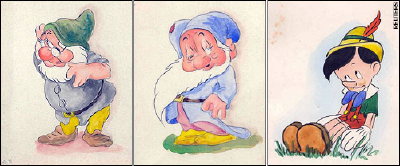
 German museum discovers its Monet is a fake
German museum discovers its Monet is a fake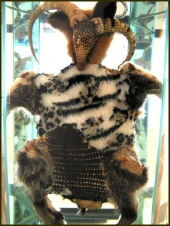 Nate Hill describes himself as a rogue taxidermist. He rummages through trash looking for dead animals: fish, dogs, cats, etc. Whatever he finds, he stitches together to form a bizarre new creature. From a recent AP article about him:
Nate Hill describes himself as a rogue taxidermist. He rummages through trash looking for dead animals: fish, dogs, cats, etc. Whatever he finds, he stitches together to form a bizarre new creature. From a recent AP article about him: Cranky Media Guy sent me an interesting link to an article published last December in the New York Times about the artist Richard Prince. He's described as a pioneer of "appropriation art." What this means is that Prince takes photographs of other photographer's photographs, and then displays them as his own. For instance, he had an exhibit at the Guggenheim about cowboys, which basically consisted of photographs of Marlboro ads. The guy who actually took the images for the Marlboro ads, the photographer Jim Krantz, visited the exhibit and was like, "Hang on, those are my photographs!"
Cranky Media Guy sent me an interesting link to an article published last December in the New York Times about the artist Richard Prince. He's described as a pioneer of "appropriation art." What this means is that Prince takes photographs of other photographer's photographs, and then displays them as his own. For instance, he had an exhibit at the Guggenheim about cowboys, which basically consisted of photographs of Marlboro ads. The guy who actually took the images for the Marlboro ads, the photographer Jim Krantz, visited the exhibit and was like, "Hang on, those are my photographs!" Back in 2000 a graphic design magazine called Dot Dot Dot ran an article about a subversive artist from the 1950s called Ernst Bettler. Design Observer summarizes the article's central tale:
Back in 2000 a graphic design magazine called Dot Dot Dot ran an article about a subversive artist from the 1950s called Ernst Bettler. Design Observer summarizes the article's central tale: The last time the famous Flower portrait of Shakespeare (the one showing him wearing a wide white collar) made news was back in 2005, when experts at the National Portrait Gallery declared it a fraud painted sometime during the 19th century.
The last time the famous Flower portrait of Shakespeare (the one showing him wearing a wide white collar) made news was back in 2005, when experts at the National Portrait Gallery declared it a fraud painted sometime during the 19th century.

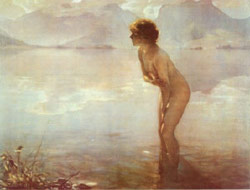 Elliot's newest contribution in the Hoaxipedia is an entry about the career of the art forger Elmer de Hory.
Elliot's newest contribution in the Hoaxipedia is an entry about the career of the art forger Elmer de Hory.  This has nothing to do with hoaxes, but I thought it was interesting, so I'm posting about it anyway. Also, it reminded me of the Compliment Machine, which I posted about just a few days ago.
This has nothing to do with hoaxes, but I thought it was interesting, so I'm posting about it anyway. Also, it reminded me of the Compliment Machine, which I posted about just a few days ago.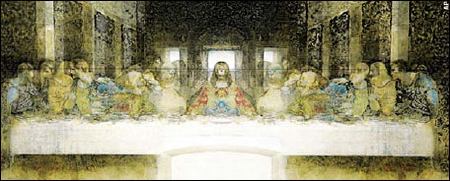
 No form of deception is more ubiquitous in modern life than the cheery platitudes we constantly exchange: "How are you?" "Fine!" or "Have a nice day."
No form of deception is more ubiquitous in modern life than the cheery platitudes we constantly exchange: "How are you?" "Fine!" or "Have a nice day."